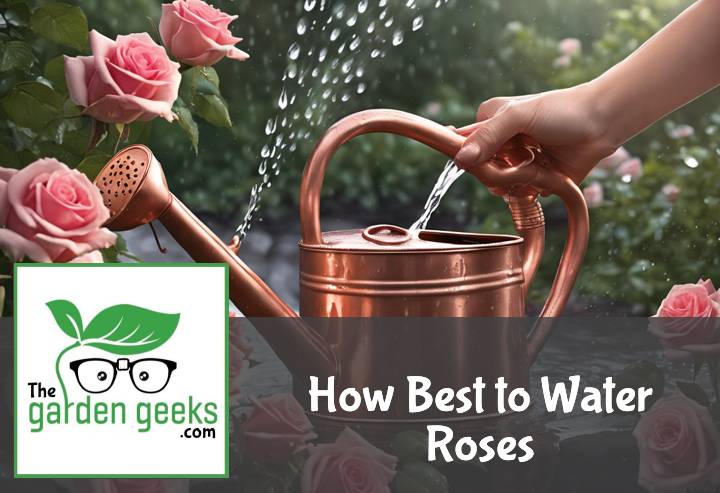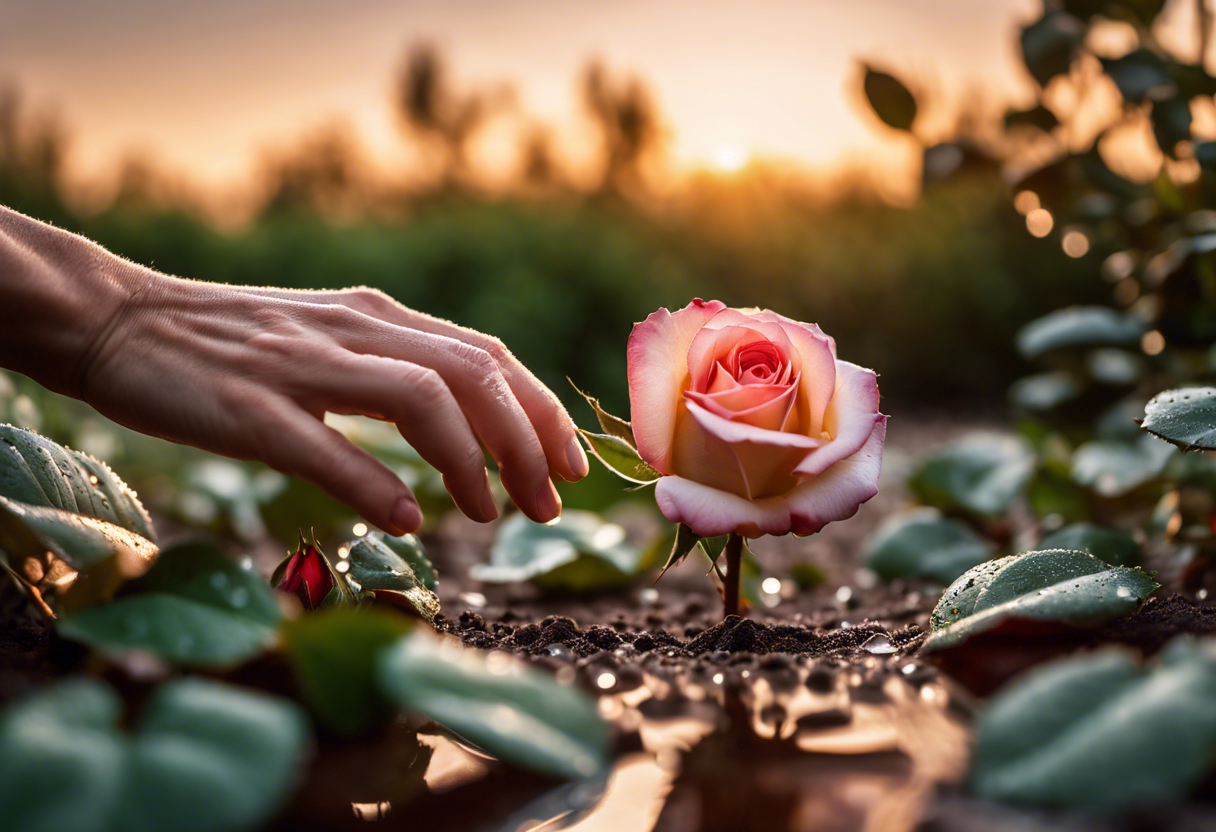Ever stared at your roses, watering can in hand, and wondered, “Am I doing this right?” Well, you’re not alone. The art of How Best to Water Roses is something that’s puzzled gardeners for centuries.
But don’t worry! You’re about to embark on a fun-filled journey where we’ll unravel the mystery together. Keep reading about How Best to Water Roses (7 Useful Tips).
Key Takeaways
- Water roses in the morning to prevent diseases and allow for maximum absorption.
- Use a soaker hose or drip irrigation system to water at the roots, avoiding wet leaves.
- Provide 1 inch of water per week, more during hot weather.
- Mulch around the base of roses to retain moisture.
- Do not overwater; it can cause root rot.
- Adjust watering based on season and climate.
- Monitor soil moisture levels regularly.
Understanding the Needs of Roses
Roses, like any other plant, have their own unique needs. And when it comes to rose care, one of the most crucial aspects is understanding their watering needs. You see, roses aren’t just your average Joe in the garden; they’re a bit high maintenance. But don’t let that scare you off! With a little knowledge and some tender loving care, your roses can thrive.
The Importance of Water for Roses
Water is like liquid gold for roses. It’s not just about keeping them hydrated; water plays a vital role in their overall development and bloom. When you’re watering roses, you’re essentially fueling their growth engine.
Without adequate water, your roses may struggle to reach their full potential. They might become stunted or produce fewer blooms. Worse still, they could fall victim to various diseases or pests due to weakened health.
So remember folks, when it comes to rose health, water isn’t just important – it’s essential!
How Different Types of Roses Have Different Watering Needs
Now here’s where things get interesting: not all roses are created equal! Yep, different types of roses have different watering needs. It’s like how some people need eight hours of sleep while others can function on six (lucky them!).
For instance, climbing roses generally require more frequent watering than shrub roses due to their vigorous growth habit. On the other hand, miniature roses often need less water because of their small size.
So next time you’re tending to your garden, remember this: knowing your rose varieties and understanding their specific watering needs is key in mastering how best to water roses. Happy gardening!
When to Water Your Roses
Knowing when to water your roses is crucial in maintaining a healthy rose garden. It’s not just about dumping a bucket of water on them whenever you feel like it. You’ve got to follow a proper rose watering schedule that aligns with their natural growth and blooming cycles.
Best Time of Day to Water Roses
So, what’s the optimal time for watering roses? Well, it’s either early in the morning or late in the evening. Why so specific? Let me explain.
Watering your roses in the morning gives them plenty of time to absorb the water before the heat of the day evaporates it. Plus, any excess water on the leaves will dry out, reducing the risk of fungal diseases. That’s why morning watering for roses is often recommended.
On the other hand, if you’re more of a night owl, evening rose irrigation can also work. Just make sure you’re only watering the base and not getting those pretty petals wet. This helps prevent overnight moisture buildup which can lead to disease.
In essence, finding an optimal daily watering schedule for roses is all about balancing hydration needs with disease prevention.
Seasonal Considerations for Watering Roses
Now let’s talk about how seasons play into this whole rose care routine. Depending on where you live, your rose hydration timing might need some tweaking as seasons change.
During summer months when temperatures soar and rain is scarce, your roses will need more frequent watering. This is where your summer rose care knowledge comes into play – keep an eye on them and adjust accordingly!
Winter presents a different challenge altogether. While you might think less sun means less water needed, cold weather can actually dry out soil quickly! So don’t neglect those winter rose watering duties!
In short, understanding how seasonal changes impact your roses’ hydration needs is key. So whether it’s summer rose care or winter rose watering tips, being mindful of the season will ensure you know how best to water roses all year round!
How Much to Water Your Roses
When it comes to how best to water roses, striking the right balance is crucial. It’s a bit like Goldilocks’ porridge – not too much, not too little, but just right! Factors such as climate, soil type, and rose variety can all influence your rose watering guide.
Determining the Right Amount of Water
So how do you calculate the correct water quantity for your roses? Well, it’s all about considering those factors we mentioned earlier. If you’re living in a hot climate or have sandy soil, your roses might be thirstier than usual. On the other hand, if you’ve got clay soil or live in a cooler climate, less is more.
Different rose varieties also have different watering needs. For instance, climbing roses require more water compared to shrub roses. So keep this in mind when planning your watering schedule.
Remember folks, proper hydration is key for maintaining rose health. But don’t worry if you’re feeling overwhelmed – there are plenty of watering tips available for every kind of rose out there!
Signs That You’re Overwatering or Underwatering
Now let’s talk signs and symptoms. If you notice yellow leaves or a lack of blooms on your plant, these could be signs that you’re overdoing it on the H2O front. On the flip side, wilting leaves and dry soil might mean your roses are parched.
Adjusting your watering practices based on these signs can help ensure optimal hydration for your roses. Remember – underwatered and overwatered rose symptoms are both bad news for our blooming buddies.
So next time you’re tending to your garden, keep an eye out for these telltale signs. Recognizing unhealthy roses early can make all the difference in their care and maintenance!
Techniques for Watering Roses
When it comes to how best to water roses, the technique you use is crucial. It’s not just about giving your roses a drink; it’s about maintaining their health and vitality. Let’s dive into some of the most effective rose watering techniques, including using a soaker hose or drip irrigation system, and good old-fashioned hand-watering.
Using a Soaker Hose or Drip Irrigation System
If you’re after efficient rose watering, look no further than a soaker hose or drip irrigation system. These systems are great at maintaining soil moisture without overwatering, which is key in preventing rose diseases.
A soaker hose for roses works by slowly releasing water directly into the soil around your plants. This method ensures that the water reaches deep down to the roots where it’s needed most. On the downside, setting up these systems can be a bit tricky and time-consuming.
Now let’s talk about drip irrigation benefits. These systems deliver water directly to the base of each plant, reducing evaporation and saving precious H2O. However, they can be more expensive than other options and require regular maintenance to keep them running smoothly.
Hand-Watering Technique
Sometimes, nothing beats getting up close and personal with your roses through hand-watering. This method allows you to control exactly how much water each plant receives, helping avoid overwatering.
Hand-watering roses also gives you an opportunity to check on your plants’ overall health. You can spot any potential problems early on before they become major issues.
The optimal watering times for this method are early morning or late evening when temperatures are cooler. This helps reduce evaporation and ensures that your roses have plenty of moisture throughout the day.
Remember though, while hand-watering has its benefits in promoting rose growth, it can be time-consuming if you have a large garden full of roses!
Factors Affecting Rose’s Water Requirements
When it comes to how best to water roses, there are a few key factors that can influence their thirst levels. The type of soil they’re planted in and the weather or climate conditions they’re exposed to play a significant role.
Impact of Soil Type on Water Retention
Different soils have different water retention abilities, which directly impacts rose watering needs. For instance, clay soil tends to hold onto water longer than sandy soil. This means if your roses are planted in clay, you might not need to water them as often.
On the other hand, sandy soil drains quickly and doesn’t retain much moisture. So, if your roses are kicking back in a sandy bed, they’ll likely need more frequent watering. These rose care tips with different soils can be quite handy when figuring out how often to hydrate your blooms.
Influence of Weather and Climate
Weather conditions and climate also have a say in rose watering schedules. In hot weather, roses will need more water as the heat causes quicker evaporation. So if you’re watering roses in hot weather, you might want to up the ante on your watering routine.
Cold climates can slow down the rose’s growth rate and reduce its water requirements. So for those practicing cold climate rose care, less is more when it comes to watering.
Rainfall naturally waters your roses but too much of it can lead to root rot. On the flip side, some roses are drought-resistant and can survive with less water during dry spells.
Adjusting your rose care for climate changes is essential for keeping those beauties blooming all season long!
Common Mistakes in Rose-Watering and How to Avoid Them
Alright, let’s dive into the nitty-gritty of rose-watering mistakes. It’s a common misconception that more water equals happier roses. Not quite, my friend! Overwatering or underwatering can both lead to some serious rose drama.
Overwatering and Underwatering: Finding the Balance
Overwatered roses? They’re like us after a big holiday meal – bloated and unhappy. The symptoms are pretty clear: yellow leaves, wilting, even root rot. On the flip side, underwatered roses are just as miserable. They’ll show you their distress with dry, crispy leaves.
So how do you strike that perfect balance for your roses? Well, it’s all about being observant and responsive. Keep an eye on your roses’ leaves – they’re great indicators of whether you’re hitting the sweet spot with watering.
Avoiding Disease by Properly Watering
Now let’s talk about diseases from improper watering. Yeah, it’s a thing! Rose diseases can sneak up on you if you’re not careful with your watering habits.
The good news is that proper watering techniques can help prevent these issues. So what does “proper” look like? It means watering deeply but infrequently, allowing the soil to dry out between waterings.
Remember folks, when it comes to how best to water roses, it’s not just about quantity but also quality! So go forth and hydrate those beauties responsibly!
To Wrap Up
We’ve navigated the sea of rose care, and it’s clear that watering is no drop in the ocean. It’s more like making a perfect cup of tea – every rose has its preference! How Best to Water Roses isn’t rocket science, but it requires a little finesse.
So, don your gardening gloves and treat your roses like royalty. Remember, overwatering is just as bad as forgetting to water at all. Keep our seven tips in mind and you’ll be the talk of the town with your blooming beauties!





